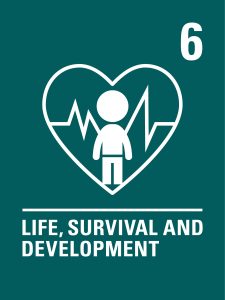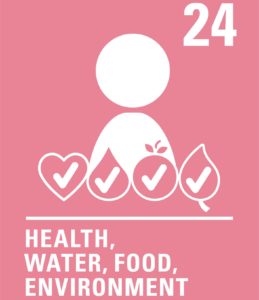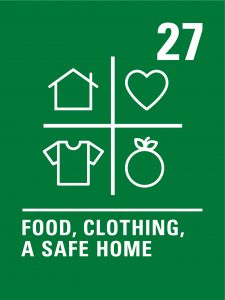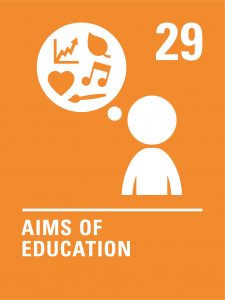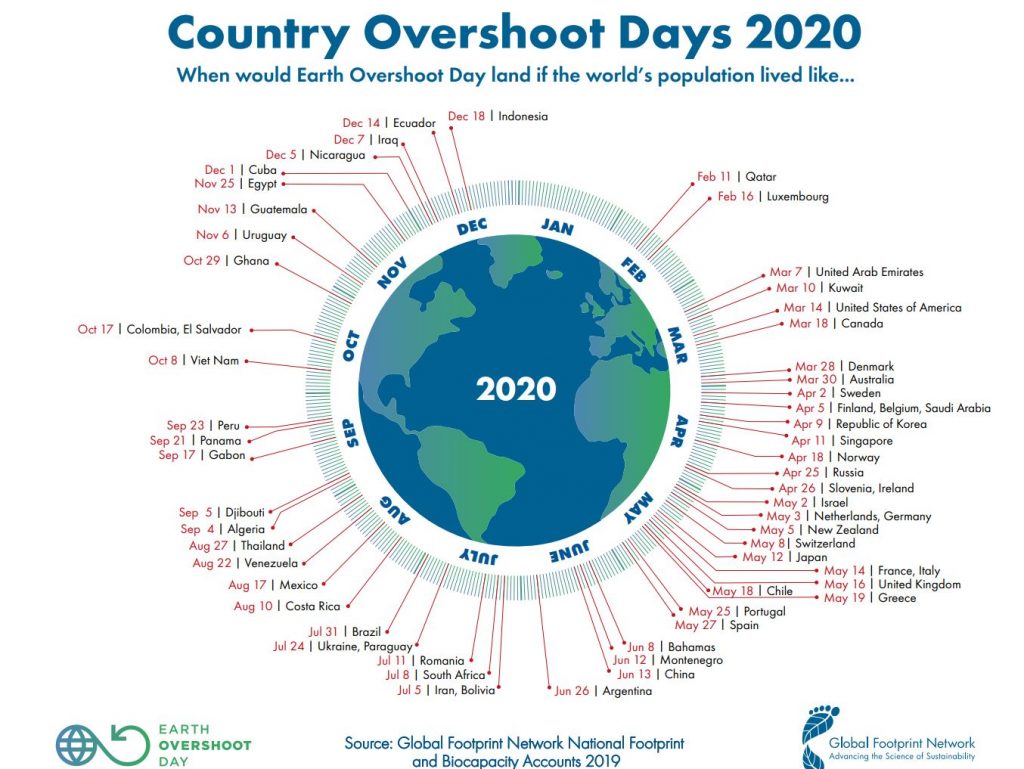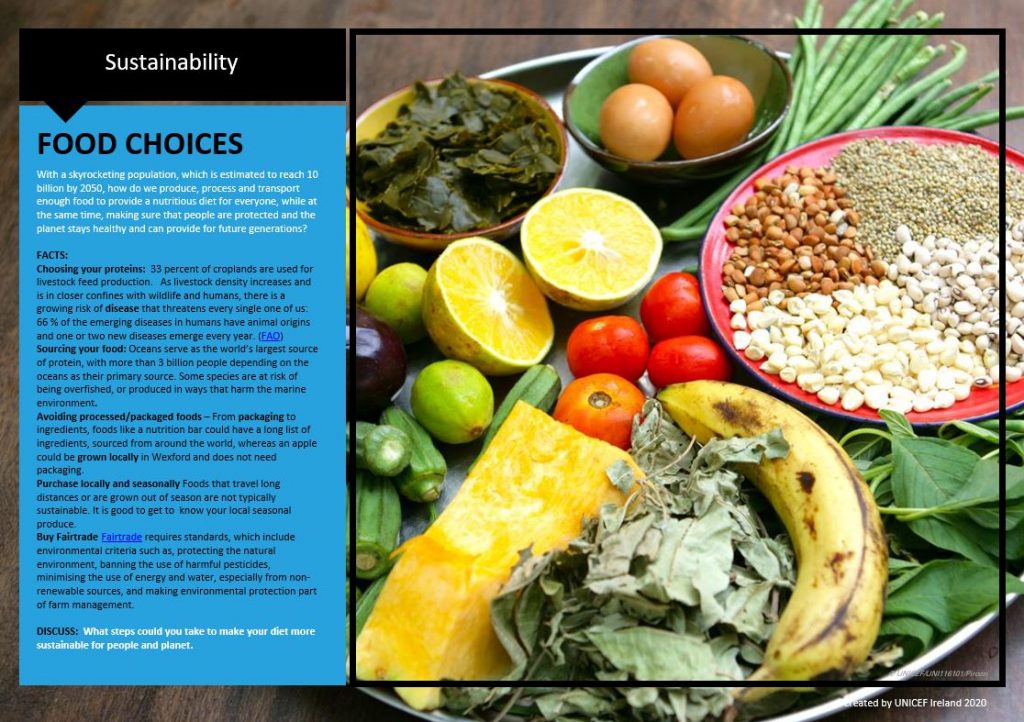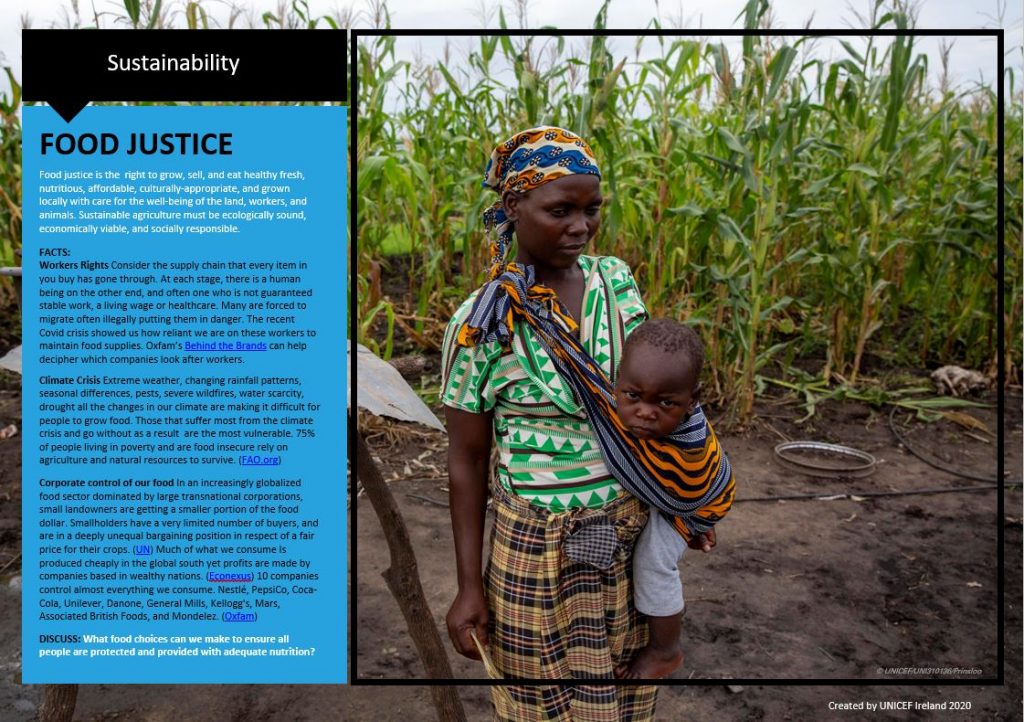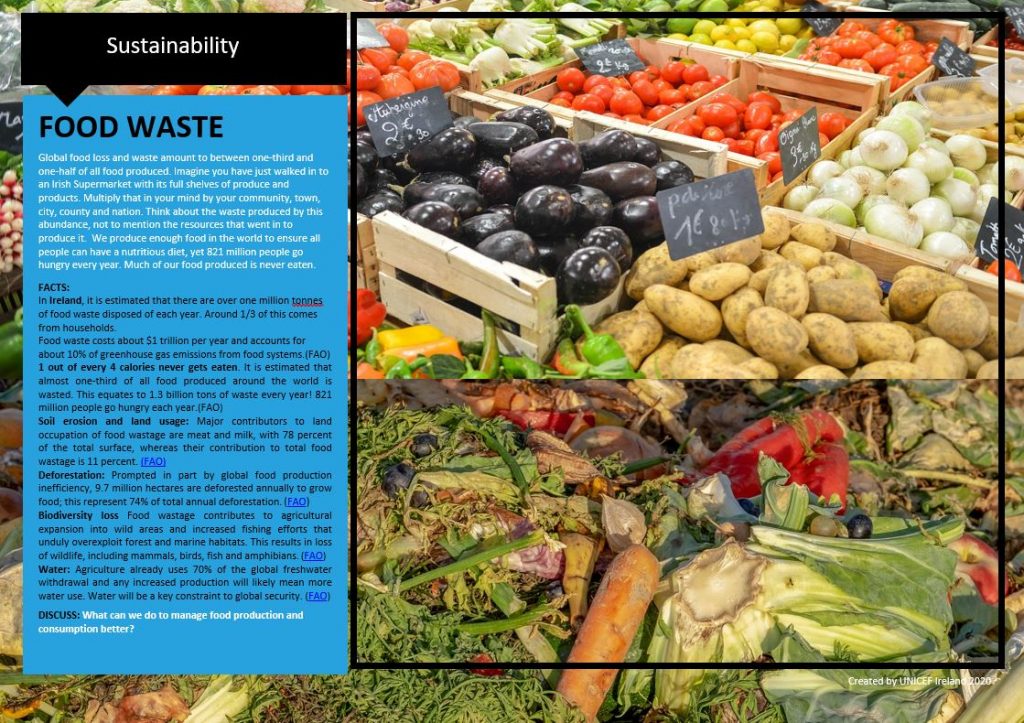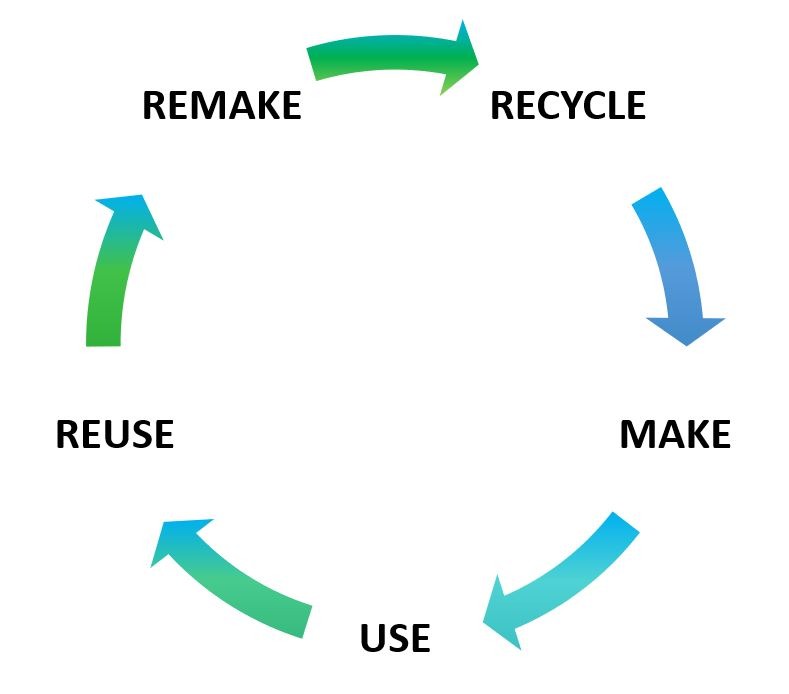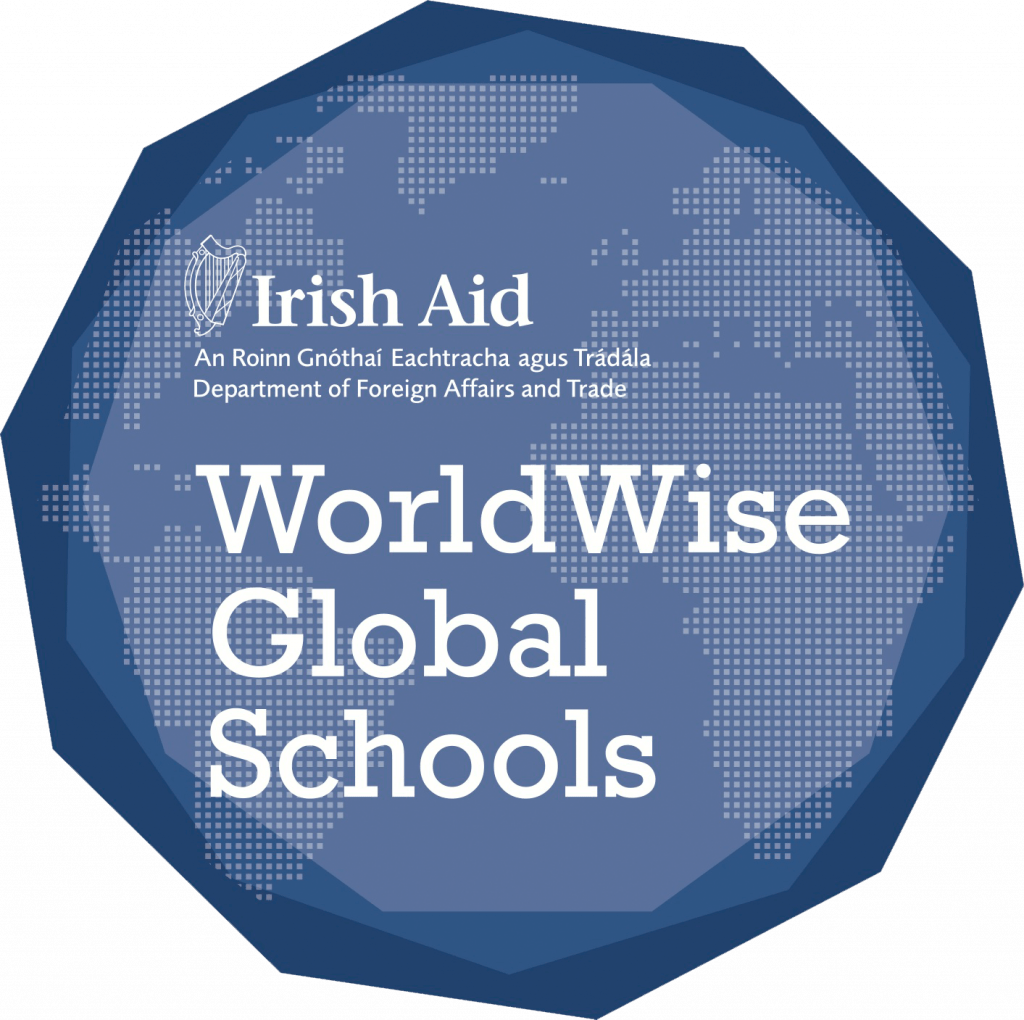Children have a right to a sustainable and healthy planet
SUSTAINABLE LIVING The impact of environmental problems, such as climate change, pollution, destruction of ecosystems and resource depletion endangers the quality of life of current and future generations of children. Children have a right to a safe, clean and healthy planet. Learn about the impact current lifestyles are having on children’s rights now and the danger it poses for their future. Explore how you can take the lead in living more sustainably and ensuring a just society for all children.
Workshop Activities
| Activity 1 | Living Sustainably | 40 mins |
| Activity 2 | Our Love of Fast Fashion | 40 mins |
| Activity 3 | Tackling Food Waste | 40 mins |
| Activity 4 | Sustainable Future | 40 Mins |
Learning Objectives
- Apply a rights-based approach to understanding sustainability.
- Critically evaluate our current consumption and production systems
- Explore better and more just ways of using finite resources.
Curriculum Connections
JUNIOR CYCLE
Statements of Learning
SOL 7: The student values what it means to be an active citizen, with rights and responsibilities in local and wider contexts.
SOL 9: The student understands the origin and impacts of social, economic, and environmental aspects of the world around her/him.
SOL 11: The student takes action to safeguard and promote her/his wellbeing and that of others
SOL 23: Brings an idea from conception to realisation
Business Studies JC 1.1 1.7, 1.9, 1.10, 2.4, 2.5, 3.1, 3.2, 3.3, 3.6, 3.7, 3.10, 3.11 SC 1.1, 1.2, 6.1, 6.5, 6.6
CSPE 1.1, 1.3, 1.8, 1.9, 1.11, 2. 1, 2.4. 2.9, 2.10
Economics 1.11.2, 1.3, 2.1, 2.2, 2.3, 2.4, 3.2,
English OL 2, 3, 4; SC 3.4.1
Geography JC 2.6; SC 3, 4, 7, 9
History JC 1.9, 1.11, 2.11, 2.13, 3.11, 3.12 SC 1.1, 1.5, 3.1, 3.3
Politics and Society 1.2, 3.1, 4.1, 4.2, 4.3, 5.1, 5.4, 6.1, 8.1
Science JC 2.7, 3.10, 4.8, 5.10
Resources
Definitions
- Sustainability: the ability of a system to last or endure; meeting current human needs without endangering our descendants
- The Ecological Footprint measures the amount of biologically productive land and sea area required to provide for the demand of the population, including the areas for growing the food, fibre, and timber they consume, the space they occupy with their houses and roads, the area needed to sequesters the carbon dioxide from burning fossil fuel.
- Biocapacity is the biologically productive area that provides renewable biological capacity including the replenishment of resources and the absorption of waste such as carbon dioxide from burning fossil fuel.
- Ecological overshoot occurs when human demand exceeds the regenerative capacity of a natural ecosystem. Global overshoot occurs when humanity demands more than what the biosphere can renew. In other words, when humanity’s Ecological Footprint exceeds what the planet can regenerate.
- Earth Overshoot Day marks the date when humanity’s demand for ecological resources (fish and forests, for instance) and services in a given year exceeds what Earth can regenerate in that year. We maintain this deficit by liquidating stocks of resources and accumulating waste, primarily carbon dioxide in the atmosphere. Andrew Simms originally conceived the concept of Earth Overshoot Day while working at the UK think tank New Economics Foundation.
- Global hectares are hectares of biologically productive land and sea area with world average bio productivity. Both biocapacity and the Ecological Footprint are measured in global hectares. (A hectare contains 10,000 square meters and corresponds to about 2.47 acres.)
- Circular Economy an alternative to a traditional linear economy (make, use, dispose) in which we keep resources in use for as long as possible, extract the maximum value from them whilst in use, then recover and regenerate products and materials at the end of each service life.
Further reading
Putting the brakes on fast fashion
Measuring your countries ecological footprint
Measuring your ecological footprint
List of Goods Produced by Child Labor
Who controls our food Report by Econexus
Teaching Notes
Ireland overshoots the planet's per person ecological footprint in
days, on the 26th of April. It would take 3 planets, for everyone to live like this.
Activity 1 – Living Sustainably
Duration: 40 mins
The aim of this activity is to open the discussion around our own impact on the planet and how we measure our needs versus our wants.
Discussion: Over the last 50 years the earth’s population has doubled, this has led to a 10 fold increase in global demand for energy, food, water and other resources. As a result, the world is facing rapid resource depletion, pollution, environmental degradation and climate change. We are pushing the earth towards its environmental limits. Humans are now consuming more resources than ever before and this is unsustainable. We overshoot our planetary limits in April, meaning we have used up our allocation of natural resources.
If you were to guess how much of the earth’s resources are extracted to meet each persons individual needs each year, what would you guess? Answer- 12 tons of natural resources were extracted per person in 2015. Do you think you would personally exceed this amount?
- 60% more clothing items are bought today than were bought 15 years ago.
- 3 billion tonnes of food is wasted each year, a third of all food produced, more than enough food to feed every undernourished person on the planet.
- 1.5 billion smartphones on average are sold worldwide each year, in 2020 1.56 billion were sold by July
- 3 planets would be needed to provide the natural resources to sustain current lifestyles if the global population reaches 9.6 billion by 2050.
To turn this around people need to learn to live sustainably, consuming what meets their basic needs for a good quality of life while minimising harm to the planet from pollution, waste and toxic emissions. They need to ensure their consumption does not prevent future generations from meeting their own needs, by ensuring the planet can regenerate.
People must also buy responsibly ensuring that the choices we make do not harm other people and their way of life. Economic globalisation has enabled producers to move manufacturing to places with cheaper labour and lower environmental standards. Which in turn makes their product cheaper to make and more affordable to buy. Consumers need to be aware that the price does not always equal the true cost to people and the planet in producing it.
Responsible consumption means, that what we choose to buy or use is good for the planet, the economy and for society.
How do individuals become responsible consumers? We can start by asking ourselves are we buying what we need or what we want. Take for example your mobile phone, is it a need or a want?
Activity: Walking debate “Is our mobile/smartphone a need or a want?”
Step 1: Divide the room into two halves. One half is defined as “I need this” the other half is defined as “I want this”. Ask participants to go to the side that represents their view and take turns debating why. Remind the group to be respectful and listen with the intent to understand the other’s point of view.
Step 2: After the debate, ask participants, “If the phone is a need, as a responsible consumer have you taken into account how it was produced?” What materials went into the product, what waste was generated and how were people affected by its production (both through the supply of goods and in the manufacturing of the product). Can you lessen the impact in any way?
- What is the environmental impact? In the EU, around 211 million smartphones are sold annually. A 2019 study stated that the annual climate impact of all EU phone stock was 14.12 million tonnes of CO2. Is your phone modular, do you repair it instead of replacing it? Do you recycle your phone at the end of its life?
- Are they ethically made? Cobalt is used in the rechargeable battery of your phone and or laptop. It likely comes for the Democratic Republic of Congo (60% of supply) where children living in poverty are exploited and forced to work in harsh conditions to mine the cobalt. What is the companies supply chain management like? Check out your phones ratings with this guide or use it for your next purchase.
Group Work: Sorting our Needs from our Wants
Step 1: Brainstorm – Ask participants to think of all the different products/consumer goods they buy, use or consume in a month. Think: essential clothes, non-essential clothes (fashion purchases) phone, computer, take away, crisps, sweets, drinks, cosmetics, medicine, hair and beauty products, shoes, entertainment, music, paper, disposable items hygiene products. Write the list on a whiteboard or flipchart.
Step 2: Small groups- Give each group a large piece of paper and ask them to divide into four sections or equal boxes. Ask them to list the items listed into a needs (top left) wants (top right). Then ask them to list the essential items they would consume or are unable to go without p(consumer staple, bottom left) and (bottom right) things you like but could go without (luxuries).
Step 3: Reflection- Discuss the outcome of the two activities. Ask participants if needs and wants are different for people around the world? Do our needs supersede the needs of others on the planet? Do our needs exceed the planetary boundaries for a sustainable planet? What actions do or can we take to ensure our choices are more sustainable?
Activity 2 – Our Love of Fast Fashion
Duration: 40 mins
The aim of this activity is to understand the impact of fast fashion on our planet and explore what actions we can take to become more responsible consumers.
Discussion: Around 100 billion items of clothing are produced around the world every year. Collectively, the world’s population buys 400 per cent more clothes than we did 20 years ago. How many items of clothes do you buy each year? The reason we buy more is that clothes are much cheaper and are not made to last, thanks to “Fast Fashion”.
What is Fast Fashion? Fast fashion is the constant production of new fashion lines, which encourages us to buy the latest trends. It keeps us wanting more because what we bought yesterday is not in style today.
Prior to fast fashion, clothes were more expensive, higher quality and lasted longer. In the 1950’s people used to buy clothing and wear it on a regular basis, today people typically only wear 20% of their wardrobe on a regular basis – a single item of clothing may be worn few times before it is thrown away.
Why should we care about fast fashion? To keep sales up and fashion affordable to the average consumer, fast fashion produces clothes at the lowest cost possible. This can be achieved by mass production, low prices and large volumes of sale. Which often means the environment and workers pay the true cost.
Environment: The fashion industry uses a vast amount of our natural resources and is one of the leading polluters. According to the UN Environment Programme
- Resources- 93 billion cubic metres of water, enough for 5 million people to survive, is used by the fashion industry every year
- Pollution- The fashion industry produces 20 per cent of global wastewater
- Emissions- Clothing and footwear production is responsible for 8% of global greenhouse gas emissions
- Waste- Every second, the equivalent of one garbage truck of textiles is landfilled or burned
Workers: According to non-profit Remake, 75 million people are making our clothes today. In order to make them less expensive
- Wages -A living wage is a human right. This is the minimum amount a worker needs to earn to meet their basic needs. Yet for the majority of workers in the global fashion industry earn poverty wages and are unable to live with dignity, earning no more than €6 a day. According to Oxfam’s report ‘Reward Work, Not Wealth It takes just four days for a CEO from one of the top five global fashion brands to earn what a Bangladeshi garment worker will earn in her lifetime. In the US, it takes slightly over one working day for a CEO to earn what an ordinary worker makes in a year.
- Worker Conditions – Clothes are often manufactured in sweatshops – factories that have very poor, socially unacceptable or illegal working conditions. People’s safety is often compromised and can even lead to death. Rana Plaza was an eight-story garment factory in Bangladesh that collapsed, killing 1,134 workers.
- Child Labour – The ILO estimates that 170 million children are engaged in child labour, with many making textiles and garments to satisfy the demand of consumers in Europe, The US and beyond. A 2018 U.S. Department of Labor report found evidence of forced and child labour in the fashion industry in Argentina, Bangladesh, Brazil, China, India, Indonesia, Philippines, Turkey, Vietnam and other countries.
Group work: Strategies for Change
Step 1: Divide participants into four strategy groups assign each group a video to watch. Ask them to write down and discuss the main strategy outlined in the video to deal with fast fashion and or overconsumption. Each group should devise an elevator pitch for their strategy. (A short, well crafted, 1-2 minute pitch, describing the strategy and why they should adopt it) (15 minutes)
Step 2: Ask each group to present their elevator pitch for their video/strategy to the wider group. (12 minutes)
Step 3: When all groups are finished, ask for a show of hands, on whether participants are likely or interested to adopt each strategy.
Extension: Ask participants to research new ways of manufacturing clothing, bio-fabrication.
Activity 3 – Tackling Food Waste
Duration: 40 mins
The aim of this activity is to examine the sustainable food choices we can make to better protect people and planet.
Discussion: Food is often consumed without thinking about the resources needed to produce it, where in the world it came from and who was involved in its production, packaging, transporting and selling of it. Occasionally we even waste food by taking what we can’t or don’t need to consume.
In order to protect our planet and ensure all people have access to nutritious food, people need to make sustainable food choices.
Here are some facts to consider from the Food and Agriculture Organisation of the United Nations on food production.
- Food production contributes more to global warming than all cars, trucks, airplanes and trains combined and is a major cause of pollution, soil degradation, deforestation and desertification, accelerating the loss of biodiversity.
- The ‘water we eat’ daily through the food we consume is much more than what we drink. It accounts for almost 70 percent of all water withdrawals, and up to 95 percent in some developing countries. (FAO)
- There is enough food produced in the world to ensure all people can have a nutritious diet. Unfortunately, 1 out of every 4 calories never gets eaten. (FAO)
- The world’s population is expected to increase by 2 billion persons in the next 30 years, from 7.7 billion currently to 9.7 billion in 2050. (UN)
Taking this into account, how do we produce enough food to provide a nutritious diet for everyone, while at the same time, making sure the planet stays healthy and can provide for future generations? Below are a few discussions worth having. Please use the discussion cards for support.
Group Work: Divide the group into 6 smaller groups, handout one of the three discussion cards to each group.
- Food Choices: What steps could you take to make your diet more sustainable for people and planet?
- Food Justice: What food choices can we make to ensure all people are protected and provided with adequate nutrition?
- Food Waste: What can we do to manage food production and consumption better?
Activity 4 – Sustainable Future
Duration: 40 Mins
The aim of this activity is to look at innovations that are leading us to a more sustainable future.
Discussion: One way toward responsible consumption is to create a circular economy, where we take material from the earth and design it to use as little raw material a possible, it is used over and over again and is repaired when broken or worn, we collect it and use as much of the product as we can to produce something else, only getting rid of a minimal amount each time.
There are also some exciting ideas starting with growing more and killing less. Innovations like biofabrication are being considered the next industrial revolution. It is viewed by some as a game-changer. It uses bacteria, fungi and algae, all of which are plentiful and easy to grow to produce products from clothes to shoes to bricks and other such building products.
All of these products can be grown in a matter of days or weeks from cells.
- Mix hemp fibres with natural glue and some water and you get hemp concrete.” as “the vegetative part of a fungus mixed with waste and compressed for 10 minutes molds into any shape to make all kinds of furniture or even bricks to build homes.
- Bacteria put into a mold of sand and a solution of urea and calcium chloride produces these bricks in a matter of days, the bacteria will form a chain of chemical reactions that will cause it to solidify and bind the brick together. It is based on the way coral grows and is CO2 negative meaning it absorbs more Co2 then it emits
- Fabric can be made from bacteria but equally fungus and algae can be good to use. It takes a few days to make at home and can biodegrade outside within a week.
Other important things are simply to rewild our planet, allowing as much land as possible to turn back to nature. Growing plants up walls and making use of internal spaces to grow food.
Activity: More than 23 billion pairs of runners are made every year, over 300 million pairs are thrown out annually, and, on average, it takes 30-40 years for a pair to fully decompose in a landfill. Ask participants to group into threes and research a pair of runners that are sustainably produced (10 min).
Each person has a role:
- to determine do the materials, have a low impact on the environment and are they ethically sourced,
- to determine is the production chain circular, minimising waste and reusing materials,
- to determine does the manufacturer have fair wages and working conditions (for all of its products).
Ask groups to present back on the shoe they found to the larger group. Discussion points: Would you buy this shoe? Is it available in the Irish market? Is it affordable? What is the most unusual product used? Does the company use these methods throughout their product lines or are these shoes a gimmick to greenwash their brand?
Video: A World of Solutions
Take Action
We all have responsibility for achieving the Sustainable Development Goals by 2030. Below are the goals and their targets that address violence against children. Use them, along with the Convention on the Rights of the Child to support your call to take action and address these issues. Below are just a few suggestions of actions you can take.
Tools
Explore
This activity can help your school achieve a Global Passport Award. Learn more or apply at WWGS’s Global Passport Award.
Funded by Irish Aid’s WorldWise Global Schools – contents are the responsibility of its author and do not necessarily represent or reflect WWGS and or Irish Aid policy.
